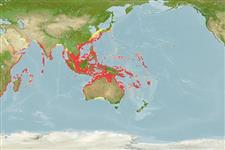Classification / Names
Common names from other countries
Main reference
Size / Weight / Age
Max length : 120 cm TL male/unsexed; (Ref. 47613); max. published weight: 15.0 kg (Ref. 11228); max. reported age: 22 years (Ref. 3627)
Length at first maturity
Lm 48.3, range 25 - 30 cm
Environment
Marine; brackish; reef-associated; depth range 1 - 100 m (Ref. 167)
Climate / Range
Subtropical, preferred 28°C (Ref. 107945); 37°N - 34°S, 28°E - 180°E (Ref. 5222)
Distribution
Indo-West Pacific: Red Sea south to at least Durban, South Africa and eastward to Palau and Fiji, north to the Ryukyu Islands, south to the Arafura Sea (Ref. 9819) and Australia. Recently reported from the Mediterranean coast of Israel (Ref. 5222). Frequently misidentified as Epinephelus tauvina or Epinephelus malabaricus (Ref. 27362).
Countries | FAO areas | Ecosystems | Occurrences | Introductions
Short description
Dorsal
spines
(total): 11;
Dorsal
soft rays
(total): 13-16;
Anal
spines: 3;
Anal
soft rays: 8. Small individuals closely resemble E. tauvinaand E. malabaricus, but have orange spots and lack hexagonal spots on the fins (Ref. 37816); head and body tan dorsally, shading to whitish ventrally; numerous small brownish orange or reddish brown spots on head, body and median fins (Ref. 89707); further characterized by having overall tan color; four irregular H-shaped dark bars; back with 3-4 blackish saddles; head, body and fins with numerous small brownish orange or reddish brown spots; body scales ctenoid except for nape, back, thorax, abdomen and above anal-fin base with cycloid scales; greatest depth of body 2.9-3.7 in SL; rounded caudal fin; short pelvic fins, 1.9-2.7 in head length (Ref. 90102).
IUCN Red List Status (Ref. 115185)
Threat to humans
Harmless
Human uses
Fisheries: commercial; aquaculture: commercial
More information
ReferencesAquacultureAquaculture profileStrainsGeneticsAllele frequenciesHeritabilityDiseasesProcessingMass conversion
Tools
Special reports
Download XML
Internet sources
Estimates of some properties based on models
Phylogenetic diversity index
PD50 = 0.5000 many relatives (e.g. carps) 0.5 - 2.0 few relatives (e.g. lungfishes)
Trophic Level
4.0 ±0.0 se; Based on diet studies.
Resilience
Low, minimum population doubling time 4.5 - 14 years (K=0.17; tm=2-3; tmax=22; Fec=43,618)
Vulnerability
High vulnerability (58 of 100)
Price category
